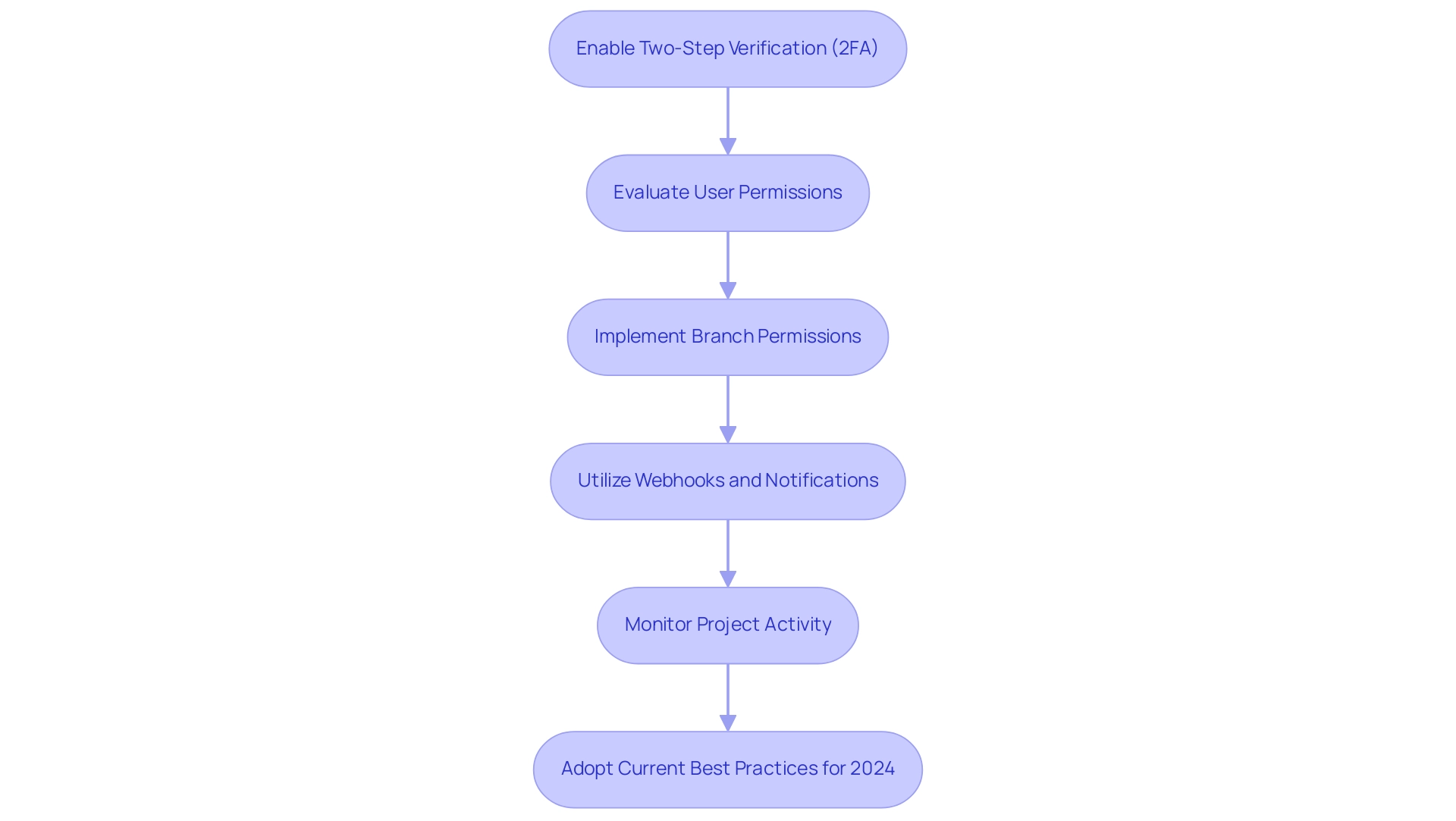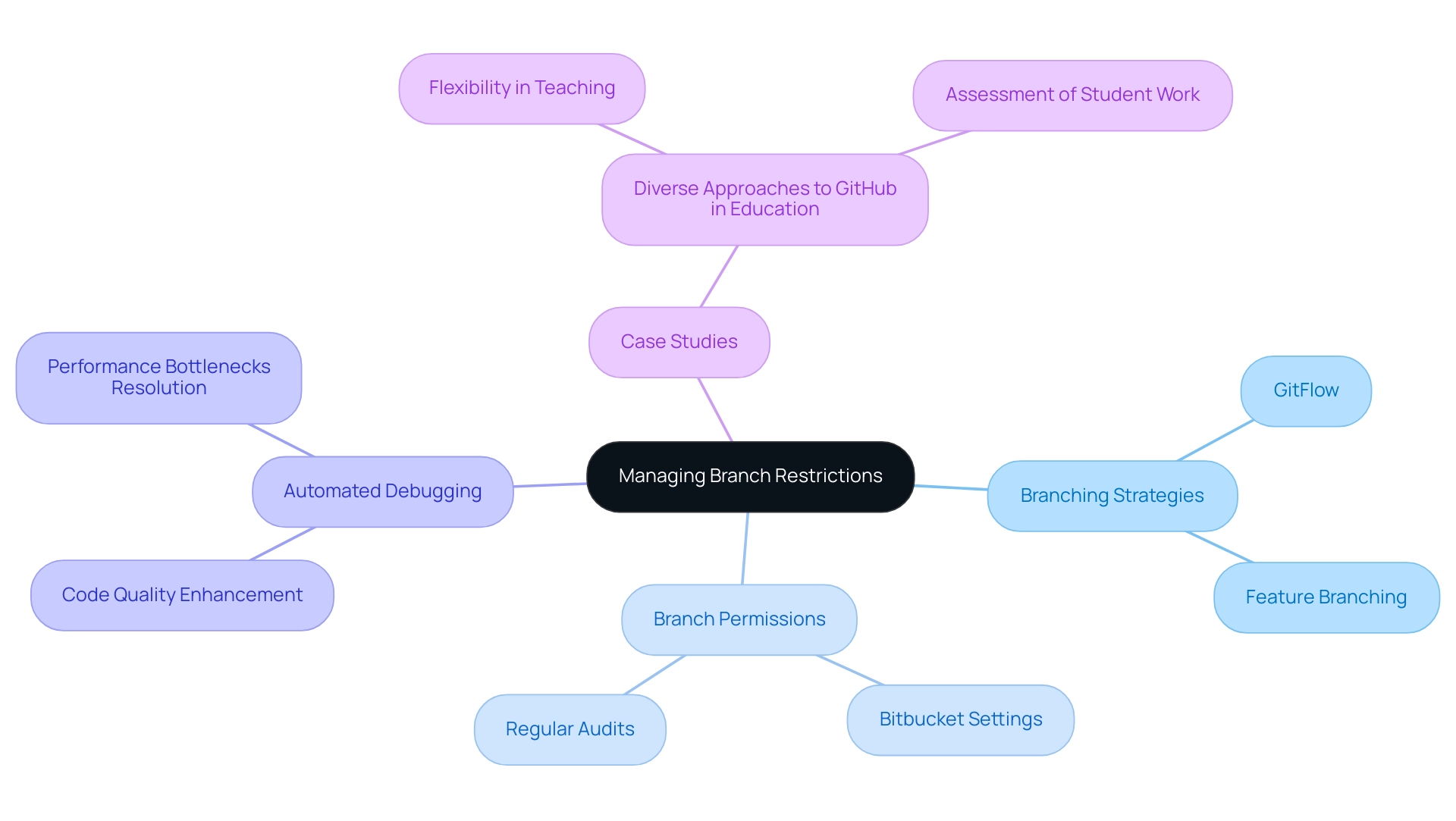Introduction
In the dynamic realm of software development, mastering tools like Bitbucket can be the key to unlocking unparalleled efficiency and productivity. As teams navigate the complexities of coding, collaboration, and security, understanding the Bitbucket interface and its myriad features becomes essential. From optimizing repository settings to implementing robust security measures, each element plays a crucial role in streamlining workflows and enhancing code quality.
By integrating powerful tools and adopting best practices, developers can not only safeguard their projects but also foster a collaborative environment that drives innovation. This article delves into the essential strategies for leveraging Bitbucket effectively, ensuring that development teams are well-equipped to meet the demands of today’s fast-paced tech landscape.
Navigating the Bitbucket Interface and Repository Basics
While Bitbucket's interface may appear daunting at first glance, mastering its layout can dramatically enhance your development workflow. Start your journey on the dashboard, your gateway to all collections. Each repository includes several important tabs:
- The 'Source' tab allows you to view and manage your files efficiently.
- The 'Commits' tab enables you to track changes seamlessly.
- The 'Pull Requests' tab is crucial for facilitating reviews and collaboration.
With Kodezi’s AI-driven automated reviews, developers can improve their modifications throughout the software creation lifecycle, ensuring high-quality output with each release. Kodezi's automated testing actively identifies bugs during the creation process, allowing developers to address issues before they escalate, thus maintaining code integrity and quality. Furthermore, the 'Settings' menu provides options to tailor Bitbucket repository settings for specific configurations.
Significantly, Bitbucket connects with over 50 frequently utilized developer tools, highlighting its versatility and importance in the workflow. By becoming familiar with these foundational elements and utilizing Kodezi's automated testing to catch bugs early, you can significantly streamline your process and minimize the time spent navigating through features and settings as your projects evolve. This combined approach not only accelerates productivity but also fosters a more organized workflow.
As GitLab states, 'From project planning and source code management to CI/CD and monitoring, GitLab is a complete DevOps platform, delivered as a single application.' This comparison highlights the platform's strengths within the wider context of programming tools. Additionally, utilizing third-party tools like Awesome Graphs for other platforms can help teams track pull request metrics effectively, providing a comprehensive overview of the development process.
This tool simplifies the process of finding necessary statistics, saving time and enabling data-driven decision-making.
Implementing Security Best Practices for Your Bitbucket Repositories
To enhance the security of your Bitbucket repository settings, the first step is to enable two-step verification (2FA) for all users. This essential measure adds an extra layer of authentication, making it significantly more challenging for unauthorized individuals to gain access. Implementing 2FA not only protects sensitive data but also builds customer trust, a crucial aspect for e-commerce platforms.
As evidenced by recent trends, the adoption of 2FA in various sectors has surged; in fact, a staggering 56.7% of businesses implemented authentication applications during security breaches as of 2021, contrasting sharply with the mere 6.7% that relied on secondary MFA via email. According to cybersecurity experts,
Two-factor authentication (2FA) is one of the types of multi-factor authentication, highlighting its critical role in modern security frameworks, particularly in protecting confidential information.
Furthermore, a case study from Microsoft reveals that around 99.9% of identity and data theft can be avoided through the use of multi-factor authentication, reinforcing the necessity of 2FA in preventing unauthorized access. It is also essential to perform regular evaluations of user permissions and access levels within the Bitbucket repository settings to ensure that only authorized personnel can make changes to critical storage areas.
Implementing branch permissions in the Bitbucket repository settings is another best practice that restricts who can push changes to essential branches, particularly the main branch, thus minimizing the risk of accidental disruptions.
To enhance oversight, utilize webhooks and notifications to monitor project activity. This proactive approach enables the early detection of any unusual behavior, thereby strengthening your system's defenses against potential threats. By adopting these current best practices for repository security in 2024, you not only protect sensitive data but also foster trust among users and stakeholders.

Managing Branch Restrictions to Enhance Workflow Control
Implementing branch restrictions in the repository is essential for maintaining a clean and functional codebase, significantly enhancing team productivity. Established in 2010, GitFlow remains a relevant branching strategy for managing complex software development processes. Begin by establishing a clear branching strategy, such as Git Flow or Feature Branching.
Utilizing the bitbucket repository settings for branch permissions allows you to precisely control who can merge changes into critical branches like 'master' or 'main,' ensuring that only authorized and reviewed contributions are integrated, thereby safeguarding the production environment against potential disruptions. To enhance this process further, leverage automated debugging tools that instantly identify and fix issues in the codebase, providing detailed explanations and insights into what went wrong and how it was resolved. This ensures compliance with the latest security best practices and coding standards.
This approach not only resolves performance bottlenecks but also optimizes code quality through effective exception handling and enhanced formatting. Regular audits and updates of branch permissions are crucial as team roles and projects evolve, ensuring your workflow remains efficient and secure. A recent study indicates that structured branch restrictions can lead to a marked improvement in version control effectiveness.
Furthermore, case studies on diverse approaches to GitHub in education demonstrate how different instructional teams utilize various models for GitHub integration, allowing for flexibility in teaching and assessing student work. These examples further solidify the necessity of these practices in contemporary workflows.

Integrating Bitbucket with Other Tools for Streamlined Workflows
Integrating the repository management system with tools such as Jira, Trello, or Slack can dramatically enhance workflow efficiency. For instance, when the code repository is linked with Jira, developers can effortlessly track issues and manage projects, creating a seamless transition from code development to task management. This integration not only simplifies the process but also minimizes delays, as pull requests can take 24-48 hours to process fully, making timely project updates essential.
Additionally, the recent enhancements in Jenkins' webhook capabilities for other platforms allow for improved automation in testing and deployment. This optimization benefits users by reducing manual errors and accelerating release cycles, enabling teams to respond more swiftly to market demands. A practical example of this is the integration with JetBrains IDEs, which enables developers to review pull requests directly within their development environment, streamlining the code review process.
Furthermore, organizations can maximize their use of integrations by exploring additional services such as:
- Business process analysis
- Configuration audits
- Training
Explore the marketplace to discover various integrations that best suit your team’s requirements and enhance collaboration across your projects.
Configuring Repository Settings for Optimal Workflow Customization
To maximize workflow efficiency, it is essential to configure your Bitbucket repository settings. Begin by establishing branch rules tailored to your team's development process; for instance, mandate pull requests for merging into critical branches. This practice not only improves quality but also promotes better collaboration among team members.
Incorporating automated debugging into your workflow enables the immediate identification and resolution of issues within the codebase, offering detailed explanations and insights into what went wrong and how it was resolved, ensuring adherence to security best practices and enhancing overall quality. Customizing notification settings is equally important; ensure your team receives alerts for significant events without being inundated by irrelevant updates, thus maintaining focus on critical tasks. Establish a systematic storage system by creating organized directories for programming and documentation, which enables easy navigation and access.
With a total of 7,262 commits reported by the Awesome Graphs REST API, it’s evident that active engagement in project management can significantly impact project success. As your project evolves, it's crucial to regularly reassess and adjust the Bitbucket repository settings to align with your team's changing needs. A FinTech company exemplifies this approach by integrating Bitbucket with Awesome Graphs to streamline their code review processes and incorporate automated debugging, which not only leads to faster deployment cycles but also ensures adherence to coding standards and security best practices.
As Eradicatore noted, 'thanks, yea, this is a really old package but still worked for my purpose,' highlighting the importance of reliability in configuration setups. Embracing these current best practices not only optimizes repository management but also significantly enhances overall team productivity.
Conclusion
Mastering Bitbucket is essential for any development team aiming to enhance efficiency and productivity. By navigating the interface and understanding the repository basics, teams can streamline their workflows significantly. The integration of automated tools, such as Kodezi for code reviews and debugging, empowers developers to maintain high-quality code while minimizing potential disruptions.
Security practices, including the implementation of two-step verification and regular permissions audits, play a crucial role in safeguarding repositories. These measures not only protect sensitive data but also foster trust within the team and with stakeholders. Coupled with effective branch restrictions, teams can ensure that only authorized changes are made to critical branches, maintaining a clean and functional codebase.
Integrating Bitbucket with tools like Jira and Trello further enhances workflow efficiency, allowing for seamless project management and timely updates. Customizing repository settings to fit the specific needs of the team ensures that everyone remains focused on critical tasks without unnecessary distractions.
Ultimately, leveraging Bitbucket’s features and best practices equips development teams to meet the challenges of a fast-paced tech landscape. By embracing these strategies, teams can unlock their full potential, driving innovation and achieving remarkable outcomes in their projects.
Boost your coding efficiency today—try Kodezi for seamless code reviews and automated debugging!
Frequently Asked Questions
What is the purpose of the Bitbucket dashboard?
The Bitbucket dashboard serves as the gateway to all collections, allowing users to access and manage their repositories effectively.
What are the key tabs available in each Bitbucket repository?
Each Bitbucket repository includes several important tabs: 1. The 'Source' tab for viewing and managing files, 2. The 'Commits' tab for tracking changes, 3. The 'Pull Requests' tab for facilitating reviews and collaboration.
How does Kodezi enhance the development workflow in Bitbucket?
Kodezi provides AI-driven automated reviews and testing that help developers improve their modifications, identify bugs early, and maintain code integrity and quality throughout the software creation lifecycle.
What options are available in the Bitbucket 'Settings' menu?
The 'Settings' menu allows users to tailor repository settings for specific configurations to suit their project needs.
How does Bitbucket integrate with other developer tools?
Bitbucket connects with over 50 frequently utilized developer tools, enhancing its versatility and importance in the development workflow.
What security measures can be implemented for Bitbucket repositories?
Key security measures include enabling two-step verification (2FA) for all users, regularly evaluating user permissions, implementing branch permissions to restrict changes to essential branches, and utilizing webhooks and notifications to monitor project activity.
What is the significance of two-factor authentication (2FA) in Bitbucket?
Two-factor authentication (2FA) adds an extra layer of security by requiring a second form of verification, making it more difficult for unauthorized users to access sensitive data and helping to build customer trust.
What recent trends highlight the importance of 2FA?
As of 2021, 56.7% of businesses implemented authentication applications during security breaches, emphasizing the critical role of 2FA in protecting confidential information.
How can branch permissions enhance repository security?
Implementing branch permissions restricts who can push changes to critical branches, reducing the risk of accidental disruptions and unauthorized modifications.
What proactive measures can be taken to strengthen system defenses in Bitbucket?
Utilizing webhooks and notifications to monitor project activity allows for the early detection of unusual behavior, thereby enhancing the overall security of the repository.




